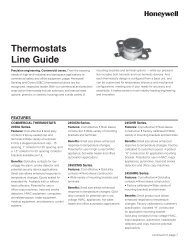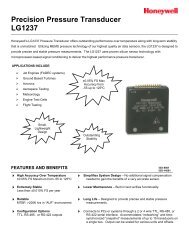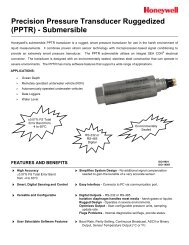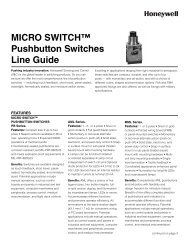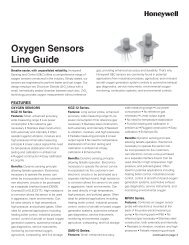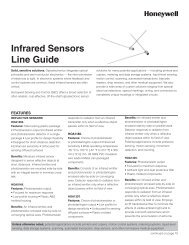Magnetometer_HMC1052.. - EasySen
Magnetometer_HMC1052.. - EasySen
Magnetometer_HMC1052.. - EasySen
- No tags were found...
You also want an ePaper? Increase the reach of your titles
YUMPU automatically turns print PDFs into web optimized ePapers that Google loves.
HMC1051/HMC1052/HMC1053<br />
The set/reset strap can be pulsed with high currents for the following benefits: 1) Enable the sensor to perform high<br />
sensitivity measurements, 2) Flip the polarity of the bridge output voltage, and 3) Periodically used to improve linearity,<br />
lower cross-axis effects, and temperature effects.<br />
NOISE CHARACTERISTICS<br />
The noise density for the HMR105X series is around 50nV/sqrt Hz at the 1 Hz corner, and quickly drops below 10nV/sqrt<br />
Hz at 5Hz and begins to fit the Johnson Noise value at just below 5nV/sqrt Hz beyond 50Hz. The 10Hz noise voltage<br />
averages around 1.4 micro-volts with a 0.8 micro-volts standard deviation.<br />
CROSS-AXIS EFFECT<br />
Cross-Axis effect for the HMR105X series is typically specified at ±3% of full scale to 1 gauss. See application note<br />
AN215 regarding this effect and methods for nulling.<br />
OFFSET STRAP<br />
The offset strap is a spiral of metalization that couples in the sensor element’s sensitive axis. In two-axis designs, the<br />
strap is common to both bridges and must be multiplexed if each bridge requires a different strap current. In three-axis<br />
designs, the A and B bridges are together with the C bridge sharing a common node for series driving all three bridges’<br />
offset straps. Each offset strap measures nominally 15 ohms, and requires 10mA for each gauss of induced field. The<br />
straps will easily handle currents to buck or boost fields through the ±6 gauss linear measurement range, but designers<br />
should note the extreme thermal heating on the die when doing so.<br />
With most applications, the offset strap is not utilized and can be ignored. Designers can leave one or both strap<br />
connections (Off- and Off+) open circuited, or ground one connection node. Do not tie both strap connections together to<br />
avoid shorted turn magnetic circuits.<br />
SET/RESET STRAP<br />
The set/reset strap is another spiral of metalization that couples to the sensor elements easy axis (perpendicular to the<br />
sensitive axis on the sensor die). Like the offset strap, the set/reset strap runs through a pair of bridge elements to keep<br />
the overall die size compact. Each set/reset strap has a nominal resistance of 3 to 6 ohms with a minimum required peak<br />
current of 400mA for reset or set pulses. With rare exception, the set/reset strap must be used to periodically condition the<br />
magnetic domains of the magneto-resistive elements for best and reliable performance.<br />
A set pulse is defined as a positive pulse current entering the S/R+ strap connection. The successful result would be the<br />
magnetic domains aligned in a forward easy-axis direction so that the sensor bridge’s polarity is a positive slope with<br />
positive fields on the sensitive axis result in positive voltages across the bridge output connections.<br />
A reset pulse is defined as a negative pulse current entering the S/R+ strap connection. The successful result would be<br />
the magnetic domains aligned in a reverse easy-axis direction so that sensor bridge’s polarity is a negative slope with<br />
positive fields on the sensitive axis result in negative voltages across the bridge output connections.<br />
Typically a reset pulse is sent first, followed by a set pulse a<br />
few milliseconds later. By shoving the magnetic domains in<br />
completely opposite directions, any prior magnetic<br />
disturbances are likely to be completely erased by the duet<br />
of pulses. For simpler circuits with less critical requirements<br />
for noise and accuracy, a single polarity pulse circuit may<br />
5 volts<br />
be employed (all sets or all resets). With these uni-polar<br />
pulses, several pulses together become close in<br />
performance to a set/reset pulse circuit. Figure 1 shows a<br />
quick and dirty manual pulse circuit for uni-polar application<br />
of pulses to the set/reset strap. Figure 1<br />
Set Pulse Circuit<br />
Iset<br />
www.honeywell.com 7





